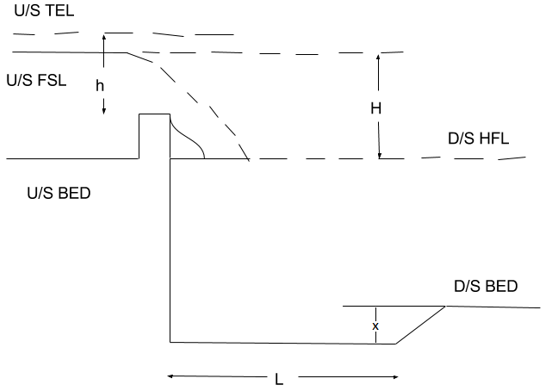This set of Basic Irrigation Engineering Questions and Answers focuses on “Canal Falls – Design of vertical Drop Fall, Baffer or Inglis Fall”.
1. In what intervals the top width of the notch lies?
a) 1/2 to full water depth
b) 3/4 to full water depth
c) Full water depth
d) 1/4 to full water depth
View Answer
Explanation: Generally the number of notches is adjusted by hit and trial method. The width of the notch lies between 3/4 to full water depth above the sill of the notch.
2. By what value the thickness of notch pier should not be less than the water depth?
a) One fourth of water depth
b) Equal to water depth
c) Half the water depth
d) Three fourth of the water depth
View Answer
Explanation: The thickness of the notch pier should not less than half of the water depth and even it can be more when the pier has to carry a superstructure.
3. The length of the weir will not exceed the bed width of the canal upstream, in case of trapezoidal notch fall.
a) True
b) False
View Answer
Explanation: In this type when the notch is provided there is heading up or drawdown of water level in the canal near the fall. Therefore the whole width of the canal is divided into number of notches. The crest is kept higher than the bed level of the canal, but in no case the total length of the weir will not exceed the bed width of the canal upstream.
4. In case of design of sarda type fall the length of crest is kept equal to ____________
a) thickness of the Canal
b) bed Width of the Canal
c) water Depth in the Canal
d) hydraulic Jump on the fall
View Answer
Explanation: In this case of designing a sarda type fall fluming is not possible, therefore the length of the crest is kept equal to the bed width of the canal.
5. In case of designing a sarda type fall the shape of the crest has one boundary level.
a) False
b) True
View Answer
Explanation: When the discharge level is under 14 cumecs rectangular crest is used. The top width is 0.55√d and base width is (h+d)/G (G = 2 for masonry). If the discharge is more than 14 cumecs then trapezoidal crest is used. Top width is equal to 0.55\(\sqrt{(H+d)}\) with upstream slope is 1: 3 and downstream slope is 1 : 8.
6. What is formula used to determine the crest level while designing a sarda type fall?
a) Q = Cd x \(\sqrt{2g}\) x L x H3/2 x (H/Bt)1/6
b) Q = Cd x \(\sqrt{2g}\) x L x H3/4 x (H/Bt)1/4
c) Q = Cd x \(\sqrt{2g}\) x L x H1/4 x (H/Bt)1/8
d) Q = Cd x \(\sqrt{2g}\) x L x H x (H/Bt)1/6
View Answer
Explanation: Discharge formula is used to determine the crest level.
Q = Cd x \(\sqrt{2g}\) x L x H3/2 x (H/Bt)1/6, where Cd = 0.415 for rectangular crest and 0.45 for trapezoidal crest, L = length of crest, Bt = Top width of crest, height of crest above bed = y – H, y = normal depth of channel.
7. What is the height of the baffle wall in case of designing inglis fall?
a) hb = yc
b) hb = y – y1
c) hb = y1
d) hb = yc – y1
View Answer
Explanation: The height of the baffle wall is given by hb = yc – y1 , where yc = critical depth given by yc = (q2/g)1/3 and y1 = 0.183 x q0.89 x HX-0.35 (HX = HL when no fluming)
Thickness of the baffle wall is 2/3hb and length of baffle wall is 5.25hb.
8. What type of design does the figure represent?

a) Single vertical drop fall
b) Sarda Type Fall
c) Baffle Fall
d) Rapids
View Answer
Explanation: In the figure, a water cushion is provided at the toe of the drop so as to reduce the impact of falling jet and thus to save the downstream floor from scouring. So therefore it is clear that the energy is dissipated by means of an impact and by sudden deflection of velocity from vertical to horizontal direction. Therefore it is a single vertical drop fall.
9. What is the shape of upstream wings in design of baffle fall?
a) Trapezoidal
b) Rectangular
c) Circular
d) Square
View Answer
Explanation: The shape given to upstream wings is circular of radius 3.6H3/2 (H = total head over crest) when H is more than 0.3m and 2H when H is less than 0.3m. These circular wings are continued till they subtend an angle of 60 degrees at the centre.
10. What type of crest width is provided in designing a straight glacis fall?
a) Deep Crest
b) Shallow Crest
c) Broad Crest
d) Narrow Crest
View Answer
Explanation: A narrow crets is to say a sharp crest is provided for a higher coefficient of discharge, thus ensuring a greater discharge capacity than that of a broad crest. It is preferred because it is economical as it reduces the cost of crest longitudinally and transversely.
Sanfoundry Global Education & Learning Series – Irrigation Engineering.
To practice basic questions and answers on all areas of Irrigation Engineering, here is complete set of 1000+ Multiple Choice Questions and Answers.
If you find a mistake in question / option / answer, kindly take a screenshot and email to [email protected]
- Apply for Civil Engineering Internship
- Apply for Agricultural Engineering Internship
- Practice Agricultural Engineering MCQs
- Check Civil Engineering Books
- Check Agricultural Engineering Books
